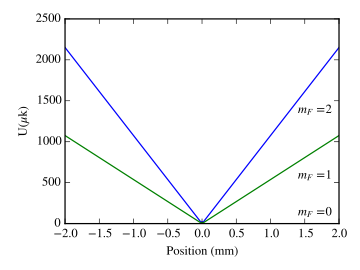Evaporative cooling (atomic physics)
Evaporative cooling is an atomic physics technique to achieve high phase space densities which optical cooling techniques typically can not reach.[1]
Atoms trapped in optical or magnetic traps are cooled as the trap depth is decreased and the hottest atoms (with the highest kinetic energy) leave the trap. The hot atoms leaving the trap are on the tail of the Maxwell-Boltzmann distribution and therefore carry away a significant amount of kinetic energy, mitigating the loss of atoms by an overall increase in phase space density. The technique is analogous to cooling a hot cup of coffee by blowing on it.

RF evaporation
Often RF (radio frequency) radiation is used to drive the hottest atoms from the trap.[2] The RF radiation is commonly referred to as an RF knife, because it cuts the hottest atoms out of the trap.
History
Evaporative cooling was developed to study the Bose–Einstein condensate, an exotic state of matter in which multiple atoms enter the same quantum state. This condensation only happens at very low temperatures: around 170 nanokelvins for rubidium atoms.
The use of kinetic evaporation was pioneered in 1995, first by Eric A. Cornell and Carl Wieman for rubidium, and then by the group of Randall G. Hulet for lithium. Since then the technique has been improved upon, notably by Bouyer's team at Groupe d'Optique Atomique Laboratoire at the Charles Fabry Optical Institute.
See also
References
- Ketterle, Wolfgang; Van Druten, N. J. (1996). "Evaporative cooling of trapped atoms". Advances in atomic, molecular, and optical physics. 37: 181–236. Bibcode:1996AAMOP..37..181K. doi:10.1016/S1049-250X(08)60101-9.
- Bouyer, P.; Boyer, V.; Murdoch, S. G.; Delannoy, G.; Le Coq, Y.; Aspect, A.; Lecrivain, M. (2000). "RF-induced evaporative cooling and BEC in a high magnetic field". p. 22. arXiv:physics/0003050.
- M. H. Anderson, J. R. Ensher, M. R. Matthews, C. E. Wieman and E. A. Cornell, Observations of Bose-Einstein Condensation in a Dilute Atomic Vapor, Science, 269:198–201, July 14, 1995.
- J. J. Tollett, C. C. Bradley, C. A. Sackett, and R. G. Hulet, Permanent magnet trap for cold atoms, Phys. Rev. A 51, R22, 1995.
- Bouyer et al., RF-induced evaporative cooling and BEC in a high magnetic field, physics/0003050, 2000.